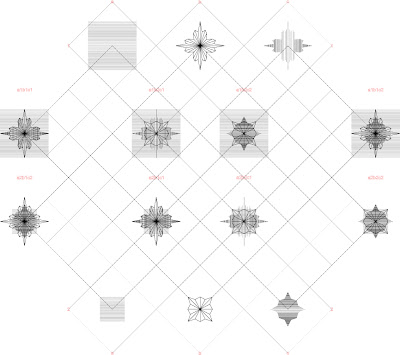1. Work with line.
2. Work with 10x10 unit.
3. Build up line to suggest depth.
4. Build up line to suggest curves.
5. Work solely with straight lines.
6. Work with line quantities in multiples of 40.
7. Use a geometric series based on 2 to create the basis for density gradients.
8. Locate all elements on center to one another.
9. Lay out grid based on 10x10 module.
10. All elements to be either parallel or normal to one another. No tangents.
11. All elements, combinations, and notation to be located on center at vertices within the grid.
12. Locate all notation within the grid.
13. No scaling; all 2 components to be smaller than 1 components but with internal lines still proportional to whole.
14. Only one turn is allowed in each path from component to combination.
Decisions that needed to have been incorporated:
1. Use line quantities in multiples of 50.
2. Determine notation size based on 10x10 unit.
3. Determine ratio of 2 components to 1 components (1:2?).
4. Use rational organization between 1s and 2s; same relationship between A-A', B-B', C-C'.
5. Create congruent logic on the placement of all notations.
6. Refine the grid to another 1 or 2 degrees.
7. Use grid to build depth within the drawing.
8. Make each path from component to combination unique.
9. Create opaque field around each component/combination so that lines do not reach actual centers. (Or, not?)
The result:

No comments:
Post a Comment